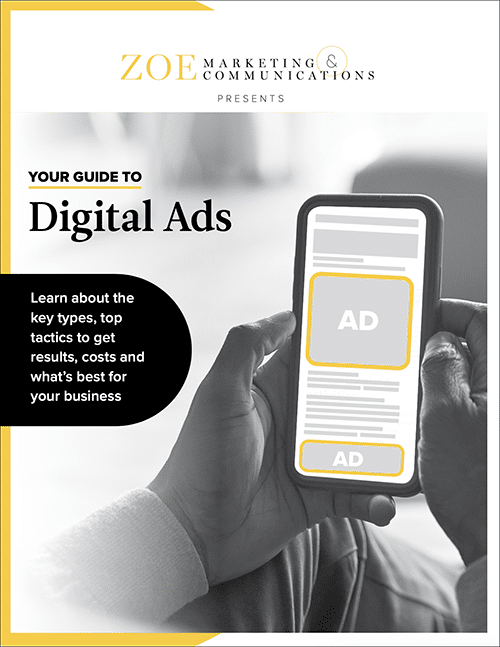
Download Your Digital Ads Guide
Learn how digital ads can help your business, including the tools, techniques and strategies to create successful campaigns.
December 8th, 2022 | 2 min. read
By Kim Kovelle

The ultimate goal in marketing is to generate sales, but there are other crucial conversions along the way that guide you to this final outcome. Tracking these conversions helps you understand how well your campaigns are performing at every stage of the customer journey.
If you’re unsure about the types of conversions, Zoe Marketing & Communications can help. Since 2020, we’ve worked with clients to measure their conversions and set realistic expectations. Here, we’ll cover some key digital marketing conversions:
These conversions work together to lead your prospects toward making a purchase.
Learn how digital ads can help your business, including the tools, techniques and strategies to create successful campaigns.
In digital marketing, a conversion is when someone takes a desired action on your ad or website. This could range from clicking on an ad to making a purchase.
Each conversion signals progress in the sales process, from initial awareness to final decision.
Click-through conversions occur when someone clicks on your ad or a specific button. It signals that they’re interested — but not necessarily ready to buy.
Clicks indicate that your message resonates and encourages people to learn more about your offer.

Not every click leads to a landing page visit. Some users may leave before the page fully loads. For those who reach your landing page, you now have an opportunity to engage them further.
Setting up a tracking pixel allows you to retarget these visitors with more ads and move them closer to a purchase.
Getting prospects to fill out a lead-generation form is a crucial step. When someone submits their contact information, it allows you to personalize future communications and build a stronger relationship.
This is an important moment, but keep in mind that these numbers will be lower than click-throughs or landing page visits.
Here, people exchange their information for something valuable, like a newsletter, webinar or free guide. Offering educational content (vs. hard selling) helps build trust — and may eventually convince people to purchase your product or service.
Even if you’re giving away valuable information, this strategy can increase long-term customer engagement.
This, of course, is the most valuable conversion Sales conversions reflect the end of the buyer’s journey, and they take significant nurturing.
It often involves multiple touchpoints, from clicks to emails to retargeting ads.
Sales conversions take time, and the process can vary greatly depending on the customer’s needs.

In addition to the primary conversions, there are other metrics worth tracking in Google Analytics:
These metrics provide a clearer picture of your website’s performance and help identify areas for improvement.
While sales conversions are the ultimate goal, the other types of conversions — such as clicks, form fills, and registrations — provide crucial insights along the way. Tracking these milestones helps you nurture leads and guide them toward a purchase.
Want to dive deeper into your conversion data? Talk to us. Zoe Marketing & Communications can help you develop a strategy that tracks and optimizes conversions across the board.
If you’re ready to explore more, check out these articles:

Learn how digital ads can help your business, including the tools, techniques and strategies to create successful campaigns.
As Zoe Marketing & Communications’ content manager, Kim Kovelle brings over 20 years of writing and editing experience in metro Detroit. She has strong roots in community journalism and a knack for making complicated topics make more sense.
